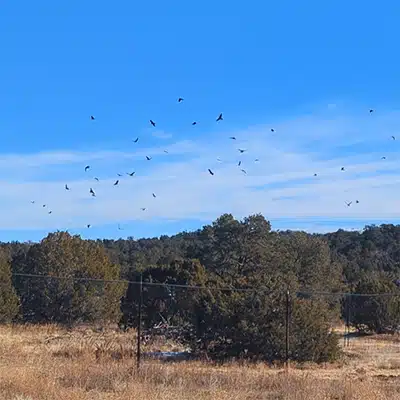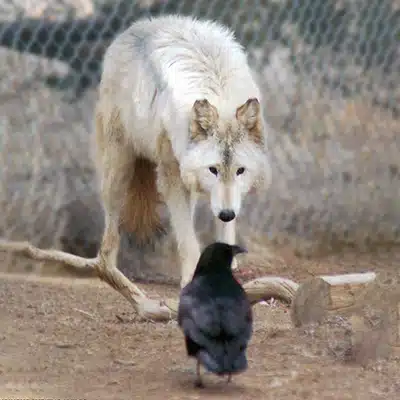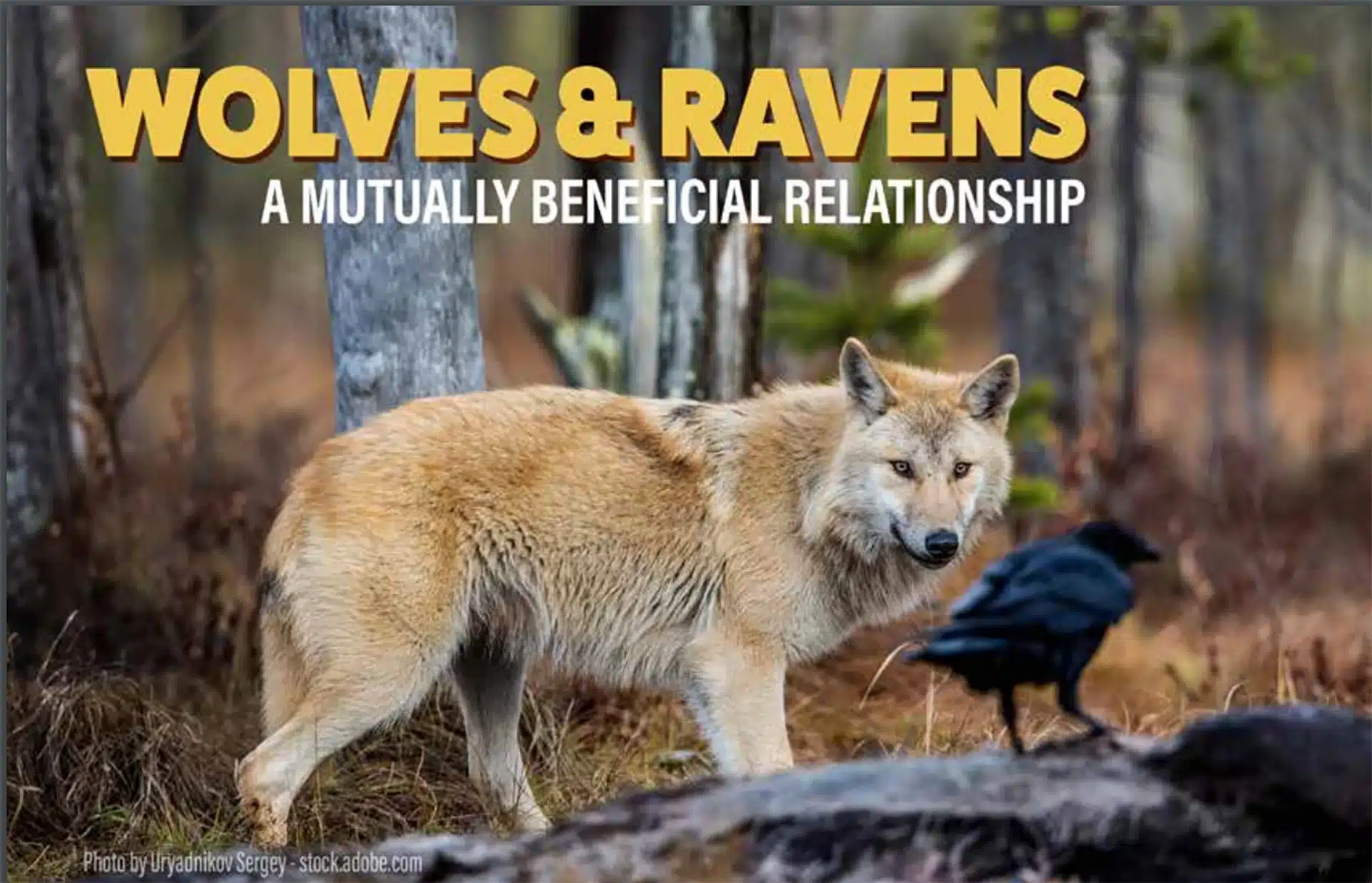If you’ve ever visited us here at Wild Spirit, you’ve likely noticed the vast number of ravens that seem to call our sanctuary home. If you’ve visited other sanctuaries or zoos with wolves, it’s likely you’ll see the same. They love to land right next to our animals in their enclosures, play in the snow around the courtyard during winter, and even tease our rescues while they’re trying to enjoy a tasty bone. We’ve even had ravens try to sneak off with our animals’ meat medication balls or snacks! Seeing all sorts of ravens around isn’t just due to our altitude or climate, there’s actually a bigger part of nature at play. Ravens are part of the corvid family, and arguably the most intelligent species of bird on the planet. With their massive brains and omnivorous diet, they’re incredibly adaptable to their environments. In addition, ravens have an attraction to shiny or glittery objects, can remember human faces, and can form family relationships and pass on generational knowledge, much like us humans. They’re known to spend time playing alone or in groups, and learning to use nature’s tools to get what they need. Ravens are so intelligent, they’ve even been observed pulling fishing line from water to pull a fish off a hook with their beak and claws.
Now, why would an intelligent bird like the raven hang around a dangerous predator like a wolf ? Both of these intelligent creatures have a very special and symbiotic relationship, and have been seen together for centuries by many cultures, some even going so far as to refer to ravens as “wolfbirds”.

Ravens, a scavenger bird, often look to large predators like wolves as potential food providers, as a big part of a raven’s diet is carrion: decaying flesh, or already dead animals. And what better place to find carrion than animals that died of natural causes, or more often, from being hunted by animals like wolves? Yellowstone National Park biologists who have been closely observing the reintroduced pack of wolves in their park have noticed that not only do ravens benefit greatly from wolves, but it even works the other way around. Ravens will often circle the sky above injured, young, or sick animals like elk and deer, and wolves have been observed taking this behavior as a cue for a hunt. It’s believed that sometimes wolves will even follow ravens’ calls, as they make loud excited noises when they find a carcass. Ravens have even been observed leading wolves to carcasses that they cannot tear into on their own. Wolves, despite what most may think, are not very good hunters—usually only making a kill one every ten tries—so they’ll often prey on weak animals. When a wolf pack makes a kill, ravens are often first on the scene. The average number of ravens present after a wolf hunt is usually upwards of 30 at a time! These birds will carry away chunks of carcass to store for later, even while the wolves are feasting right there. While this may sound like ravens are taking advantage of wolves rather than behaving symbiotically, it’s been observed and written by Bernd Heinrich that ravens actually repay the wolves by acting as “guard dogs” for them, funnily enough. Bernd Heirich writes, “At a kill site, the birds are more suspicious and alert than wolves. The birds serve the wolves as an extra pair of eyes and ears.” This is especially true as they often carry off chunks of food to safer places.

When not working together for their next meal, ravens and wolves have even been seen playing together. Ravens are highly social animals, and have especially been seen interacting with pups and yearlings, grabbing sticks and playing tug of war with the puppies. These intelligent birds will even fly over young canines with sticks or small bones to tease them, getting them to jump up and to try and grab them, or even try to initiate playing by bravely tugging on their tails or fur. Some scientists believe that individual ravens may even develop special bonds with singular wolves in a pack, just like they do with each other. Sometimes wolf pups will chase ravens themselves, and ravens will play back by diving towards the ground, then swooping away. Though we don’t have pups or the need for hunting here, lots of this behavior can be observed in captivity too. One of our rescues, Kiska, loves to chase ravens around her enclosure, only for them to fly away, then land right back where they started. We’ve even seen ravens land right next to our wolves while they are enjoying their food or a tasty bone, just to sneak away with a chunk of meat or a small discarded bone. Very frequently, we find bones littered around the sanctuary outside of enclosures from where ravens have snuck them away from our animals and dropped them out of trees. On some unique occasions, we have tossed bones into enclosures, had them get stuck in a tree, and had a raven pull them out and drop them for us!
A notable relationship between these wonderful creatures is that of our Arctic wolf, Teton, and half a dozen ravens. In his younger years, Teton loved to climb up on the wooden house in his enclosure to eat his food or chomp on bones, and we always saw a handful of ravens joining him. Some would stand right next to him, and he never minded! We were always shocked when he’d let a bird take a piece of food right from between his paws, with never a care. It’s not just wolves the ravens will form relationships with. There’s even a few ravens around the sanctuary that our staff and interns have come to recognize based on the way they look or act. It’s always fun to see them playing in the snow in winter, or resting in the shade with our wolves in the summer. It’s a little less fun when they pull our trash out of the dumpster and throw it around, though. As mentioned before, ravens can remember human faces and are attracted to shiny or glittery objects, too. Sometimes we’ll find coins, pieces of shiny metal, or colored stones and marbles on our tour path or in our courtyard, usually dropped by ravens. We like to think of these as gifts from them! Of course, we all love wolves, but it’s also wonderful to learn out about other species and the bonds they share with our canine friends. These unique creatures have formed an amazing and mutually-beneficial relationship over hundreds of years of evolution, in which both species respect each other, play together, and share resources. This special relationship is a beautiful reminder that everything in nature is connected, and reliant on others to survive.
We hope you now have a new appreciation for the ravens that also call Wild Spirit home! If you resonate with our late Teton’s love for ravens, perhaps consider picking up a memorial sponsorship in his name! Until next week, love and howls from the Wild Spirit Team.





0 Comments